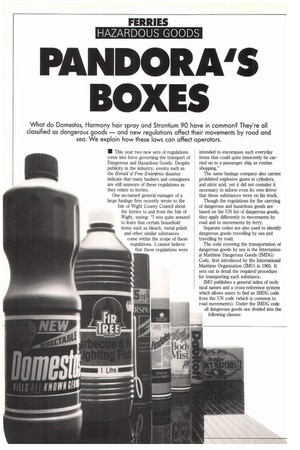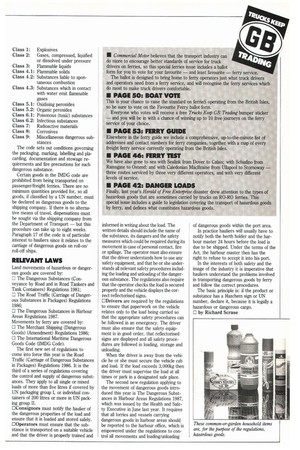PANDORA'S BOXES
Page 44

Page 45

If you've noticed an error in this article please click here to report it so we can fix it.
What do Domestos, Harmony hair spray and Strontium 90 have in common? They're all classified as dangerous goods — and new regulations affect their movements by road and sea. We explain how these laws can affect operators.
• This year two new sets of regulations come into force governing the transport of Dangerous and Hazardous Goods. Despite publicity in the industry, events such as the Herald of Free Entoprise disaster indicate that many hauliers and consignees are still unaware of these regulations as they relate to ferries.
One un-named general manager of a large haulage firm recently wrote to the Isle of Wight County Council about the ferries to and from the Isle of Wight, saying: "I was quite amazed to learn that certain household items such as bleach, metal polish and other similar substances come within the scope of these regulations. I cannot believe that these regulations were intended to encompass such everyday items that could quite innocently be carried on to a passenger ship as routine shopping."
The same haulage company also carries prohibited explosive gases in cylinders, and nitric acid, yet it did not consider it necessary to inform even its own driver that these substances were on his truck.
Though the regulations for the carrying of dangerous and hazardous goods are based on the UN list of dangerous goods, they apply differently to movements by road and to movements by ferry.
Separate codes are also used to identify dangerous goods travelling by sea and travelling by road.
The code covering the transportation of dangerous goods by sea is the International Maritime Dangerous Goods (IMDG) Code, first introduced by the International Maritime Organisation (IMO) in 1965. It sets out in detail the required procedure for transporting each substance.
IMO publishes a general index of technical names and a cross-reference system which allows users to find an IMDG code from the UN code (which is common to road movements). Under the IMDG code all dangerous goods are divided into the following classes: Class 1: Explosives Class 2: Gases, compressed, liquified or dissolved under pressure Class 3: Flammable liquids Class 4.1: Flammable solids Class 4.2: Substances liable to spontaneous combustion Class 4.3: Substances which in contact with water emit flammable gases Class 5.1: Oxidising peroxides Class 5.2: Organic peroxides Class 6.1: Poisonous (toxic) substances Class 6.2: Infectious substances Class 7: Radioactive materials Class 8: Corrosives Class 9: Miscellaneous dangerous substances The code sets out conditions governing the packaging, marking, labelling and placarding, documentation and stowage requirements and fire precautions for each dangerous substance.
Certain goods in the IMDG code are prohibited from being transported on passenger/freight ferries. There are no minimum quantities provided for, so all goods, if classified by a UN number, must be declared as dangerous goods to the shipping company. If there is no alternative means of travel, dispensations must be sought via the shipping company from the Department of Transport — but this procedure can take up to eight weeks. Paragraph 17 of the code is of particular interest to hauliers since it relates to the carriage of dangerous goods on roll-on/ roll-off ships.
RELEVANT LAWS
Land movements of hazardous or dangerous goods are covered by: O The Dangerous Substances (Conveyance by Road and in Road Tankers and Tank Containers) Regulations 1981; 0 The Road Traffic (Carriage of Dangerous Substances in Packages) Regulations 1986; 0 The Dangerous Substances in Harbour Areas Regulations 1987.
Movements by ferry are covered by: The Merchant Shipping (Dangerous Goods) (Amendment) Regulations 1986; 0 The International Maritime Dangerous Goods Code (IMDG Code).
The first new set of regulations to come into force this year is the Road Traffic (Carriage of Dangerous Substances in Packages) Regulations 1986. It is the third of a series of regulations covering the control and supply of dangerous substances. They apply to all single or mixed loads of more than five litres if covered by UN packaging group I, or individual containers of 200 litres or more in UN packing group II.
OConsignors must notify the haulier of the dangerous properties of the load and ensure that it is loaded and stored safely. ElOperators must ensure that the substance is transported on a suitable vehicle and that the driver is properly trained and informed in writing about the load. The written details should include the name of the substance, its dangers and the safety measures which could be required during its movement in case of personal contact, fire or spillage. The operator must also ensure that the driver understands how to use any safety equipment, and that he or she understands all relevant safety procedures including the loading and unloading of the dangerous substance. The regulations also require that the operator checks the load is secured properly and the vehicle displays the correct reflectorised signs.
EIDrivers are required by the regulations to ensure that paperwork on the vehicle relates only to the load being carried so that the appropriate safety procedures can be followed in an emergency. The driver must also ensure that the safety equipment is in good order, that reflectorised signs are displayed and all safety procedures are followed in loading, storage and unloading.
When the driver is away from the vehicle he or she must secure the vehicle cab and load. If the load exceeds 3,000kg then the driver must supervise the load at all times or park in a designated safe place.
The second new regulation applying to the movement of dangerous goods introduced this year is The Dangerous Substances in Harbour Areas Regulations 1987, which was issued by the Health and Safety Executive in June last year. It requires that all lorries and vessels carrying dangerous goods in harbour areas should be reported to the harbour office, which is empowered under the regulations to control all movements and loading/unloading of dangerous goods within the port area.
In practice hauliers will usually have to notify both the berth holder and the harbour master 24 hours before the load is due to be shipped. Under the terms of the Act, the harbour master then has the right to refuse to accept it into his port.
In the interests of both safety and the image of the industry it is imperative that hauliers understand the problems involved in transporting dangerous goods by ferry and follow the correct procedures.
The basic principle is: if the product or substance has a Hazchem sign or UN number, declare it, because it is legally a hazardous or dangerous cargo.
0 by Richard Scrase
































































































































